Blog - Foot Doctor, Chambersburg and McConnellsburg, PA
Before you start dancing...
How Does Athlete's Foot Occur?
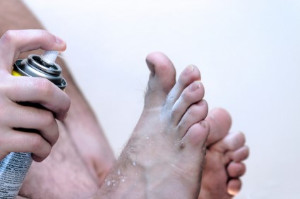 A common fungal infection of the skin on the feet is known as athlete’s foot. It typically affects the skin between the toes and the bottom of the feet, and it is considered to be contagious. The fungus that causes this condition often lives and thrives in warm and moist environments. These can include public swimming pools and surrounding areas, and shower and locker room floors. There are measures that can be taken which may help to prevent this ailment from developing. These can consist of wearing appropriate shoes while in public areas, wearing dry socks and shoes, and sharing towels should be avoided. The noticeable symptoms that are associated with athlete’s foot are itchy and burning sensations that are felt on the bottom of the feet, and the skin between the toes may appear to be red and flaky. An effective treatment option can include using an antifungal powder or cream, in addition to taking prescribed medication for severe cases. If you have developed athlete’s foot, it is suggested that you seek the counsel of a podiatrist who can properly treat this condition.
A common fungal infection of the skin on the feet is known as athlete’s foot. It typically affects the skin between the toes and the bottom of the feet, and it is considered to be contagious. The fungus that causes this condition often lives and thrives in warm and moist environments. These can include public swimming pools and surrounding areas, and shower and locker room floors. There are measures that can be taken which may help to prevent this ailment from developing. These can consist of wearing appropriate shoes while in public areas, wearing dry socks and shoes, and sharing towels should be avoided. The noticeable symptoms that are associated with athlete’s foot are itchy and burning sensations that are felt on the bottom of the feet, and the skin between the toes may appear to be red and flaky. An effective treatment option can include using an antifungal powder or cream, in addition to taking prescribed medication for severe cases. If you have developed athlete’s foot, it is suggested that you seek the counsel of a podiatrist who can properly treat this condition.
Athlete’s foot is an inconvenient condition that can be easily reduced with the proper treatment. If you have any concerns about your feet and ankles, contact Dr. Steven Schwartz from Pennsylvania. Our doctor will treat your foot and ankle needs.
Athlete’s Foot: The Sole Story
Athlete's foot, also known as tinea pedis, can be an extremely contagious foot infection. It is commonly contracted in public changing areas and bathrooms, dormitory style living quarters, around locker rooms and public swimming pools, or anywhere your feet often come into contact with other people.
Solutions to Combat Athlete’s Foot
- Hydrate your feet by using lotion
- Exfoliate
- Buff off nails
- Use of anti-fungal products
- Examine your feet and visit your doctor if any suspicious blisters or cuts develop
Athlete’s foot can cause many irritating symptoms such as dry and flaking skin, itching, and redness. Some more severe symptoms can include bleeding and cracked skin, intense itching and burning, and even pain when walking. In the worst cases, Athlete’s foot can cause blistering as well. Speak to your podiatrist for a better understanding of the different causes of Athlete’s foot, as well as help in determining which treatment options are best for you.
If you have any questions please feel free to contact our offices located in Chambersburg, and Mcconnellsburg, PA . We offer the newest diagnostic and treatment technologies for all your foot and ankle needs.
Types of Foot Pain
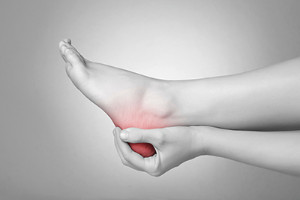 The feet are comprised of numerous bones, tendons, and ligaments, and are considered to be the foundation of the body. It is important to maintain proper foot care, as this can help to prevent different types of foot pain from occurring. The condition that is known as athlete’s foot may cause severe itching between the toes and on the bottom of the feet. It is caused by a fungus that lives in warm and damp environments, and may be avoided if appropriate shoes are worn while in public areas. A large bump that forms on the side of the big toe may be a bunion, and can develop from genetic factors, or from wearing shoes that do not fit correctly. Ingrown toenails often produce pain and discomfort, and may be avoided when the toenails are trimmed properly. If you have any type of foot pain, it is strongly suggested that you consult with a podiatrist who can offer the best course of treatment for you.
The feet are comprised of numerous bones, tendons, and ligaments, and are considered to be the foundation of the body. It is important to maintain proper foot care, as this can help to prevent different types of foot pain from occurring. The condition that is known as athlete’s foot may cause severe itching between the toes and on the bottom of the feet. It is caused by a fungus that lives in warm and damp environments, and may be avoided if appropriate shoes are worn while in public areas. A large bump that forms on the side of the big toe may be a bunion, and can develop from genetic factors, or from wearing shoes that do not fit correctly. Ingrown toenails often produce pain and discomfort, and may be avoided when the toenails are trimmed properly. If you have any type of foot pain, it is strongly suggested that you consult with a podiatrist who can offer the best course of treatment for you.
Foot Pain
Foot pain can be extremely painful and debilitating. If you have a foot pain, consult with Dr. Steven Schwartz from Pennsylvania. Our doctor will assess your condition and provide you with quality foot and ankle treatment.
Causes
Foot pain is a very broad condition that could be caused by one or more ailments. The most common include:
- Bunions
- Hammertoes
- Plantar Fasciitis
- Bone Spurs
- Corns
- Tarsal Tunnel Syndrome
- Ingrown Toenails
- Arthritis (such as Gout, Rheumatoid, and Osteoarthritis)
- Flat Feet
- Injury (from stress fractures, broken toe, foot, ankle, Achilles tendon ruptures, and sprains)
- And more
Diagnosis
To figure out the cause of foot pain, podiatrists utilize several different methods. This can range from simple visual inspections and sensation tests to X-rays and MRI scans. Prior medical history, family medical history, and any recent physical traumatic events will all be taken into consideration for a proper diagnosis.
Treatment
Treatment depends upon the cause of the foot pain. Whether it is resting, staying off the foot, or having surgery; podiatrists have a number of treatment options available for foot pain.
If you have any questions, please feel free to contact our offices located in Chambersburg, and Mcconnellsburg, PA . We offer the newest diagnostic and treatment technologies for all your foot care needs.
Toddlers And Walking Barefoot
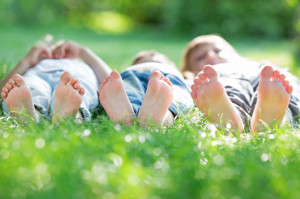 There are several bones, joints, and ligaments that the human foot is comprised of. When babies are born, their feet are flexible, and will gradually become stronger as walking begins. Babies are typically born with flat feet, and the arch generally develops as the feet become stronger. Research has indicated that it is beneficial for toddlers to walk barefoot while indoors, and this can help the toes to strengthen by grasping the floor. When the first pair of shoes are purchased, the feet should be properly measured, and this is helpful in determining the correct shoe size. It is important that the shoes have flat and flexible soles, in addition to ensuring that there is inadequate room for the toes to move freely in. If you would like more information about how to care for your child’s feet, please consult with a podiatrist.
There are several bones, joints, and ligaments that the human foot is comprised of. When babies are born, their feet are flexible, and will gradually become stronger as walking begins. Babies are typically born with flat feet, and the arch generally develops as the feet become stronger. Research has indicated that it is beneficial for toddlers to walk barefoot while indoors, and this can help the toes to strengthen by grasping the floor. When the first pair of shoes are purchased, the feet should be properly measured, and this is helpful in determining the correct shoe size. It is important that the shoes have flat and flexible soles, in addition to ensuring that there is inadequate room for the toes to move freely in. If you would like more information about how to care for your child’s feet, please consult with a podiatrist.
The health of a child’s feet is vital to their overall well-being. If you have any questions regarding foot health, contact Dr. Steven Schwartz of Pennsylvania. Our doctor can provide the care you need to keep you pain-free and on your feet.
Tips for Keeping Children's Feet Healthy
- Make sure their shoes fit properly
- Look for any signs of in-toeing or out-toeing
- Check to see if they have Clubfoot (condition that affects your child’s foot and ankle, twisting the heel and toes inward) which is one of the most common nonmajor birth defects.
- Lightly cover your baby’s feet (Tight covers may keep your baby from moving their feet freely, and could prevent normal development)
- Allow your toddler to go shoeless (Shoes can be restricting for a young child’s foot)
- Cut toenails straight across to avoid ingrown toenails
- Keep your child’s foot clean and dry
- Cover cuts and scrapes. Wash any scratches with soap and water and cover them with a bandage until they’ve healed.
If you have any questions, please feel free to contact our offices located in Chambersburg, and Mcconnellsburg, PA . We offer the newest diagnostic and treatment technologies for all your foot care needs.
Symptoms and Causes of Poor Circulation
Poor circulation occurs when blood flow to a specific part of your body is reduced. 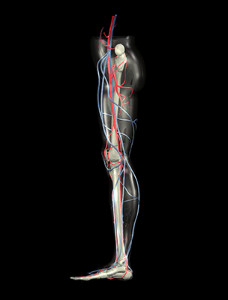 Several conditions such as heart disease, diabetes, and obesity, can all lead to poor circulation. Unhealthy behaviors can be attributing factors, including smoking cigarettes, lack of exercise, and having high cholesterol. Poor circulation in the feet can be caused by peripheral artery disease, or PAD. PAD is the result of a buildup of plaque in the arteries. Poor circulation is also known to cause muscle pain, stiffness, skin discoloration, and erectile dysfunction. People who have diabetes and smoke are at the greatest risk for poor blood circulation, as well as those who are over the age of 50. Exercising and maintaining a healthy lifestyle can drastically improve conditions. If you are experiencing complications from poor circulation in your lower extremities, it is advised that you consult with a podiatrist.
Several conditions such as heart disease, diabetes, and obesity, can all lead to poor circulation. Unhealthy behaviors can be attributing factors, including smoking cigarettes, lack of exercise, and having high cholesterol. Poor circulation in the feet can be caused by peripheral artery disease, or PAD. PAD is the result of a buildup of plaque in the arteries. Poor circulation is also known to cause muscle pain, stiffness, skin discoloration, and erectile dysfunction. People who have diabetes and smoke are at the greatest risk for poor blood circulation, as well as those who are over the age of 50. Exercising and maintaining a healthy lifestyle can drastically improve conditions. If you are experiencing complications from poor circulation in your lower extremities, it is advised that you consult with a podiatrist.
Poor circulation is a serious condition and needs immediate medical attention. If you have any concerns with poor circulation in your feet contact Dr. Steven Schwartz of Pennsylvania. Our doctor will treat your foot and ankle needs.
Poor Circulation in the Feet
Poor blood circulation in the feet and legs is can be caused by peripheral artery disease (PAD), which is the result of a buildup of plaque in the arteries.
Plaque buildup or atherosclerosis results from excess calcium and cholesterol in the bloodstream. This can restrict the amount of blood which can flow through the arteries. Poor blood circulation in the feet and legs are sometimes caused by inflammation in the blood vessels, known as vasculitis.
Causes
Lack of oxygen and oxygen from poor blood circulation restricts muscle growth and development. It can also cause:
- Muscle pain, stiffness, or weakness
- Numbness or cramping in the legs
- Skin discoloration
- Slower nail & hair growth
- Erectile dysfunction
Those who have diabetes or smoke are at greatest risk for poor circulation, as are those who are over 50. If you have poor circulation in the feet and legs it may be caused by PAD and is important to make changes to your lifestyle in order to reduce risk of getting a heart attack or stroke. Exercise and maintaining a healthy lifestyle will dramatically improve conditions.
As always, see a podiatrist as he or she will assist in finding a regimen that suits you. A podiatrist can also prescribe you any needed medication.
If you have any questions please feel free to contact our offices located in Chambersburg, and Mcconnellsburg, PA . We offer the newest diagnostic and treatment technologies for all your foot and ankle needs.
Possible Causes of Cracked Heels
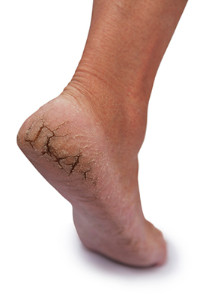 There are many patients who experience the uncomfortable condition that is known as cracked heels. It develops as a result of dry skin that forms around the heel, and can cause pain and discomfort. There are a variety of reasons why cracked heels may form. These often include standing for extended periods of time, wearing shoes that have an open back, and a dry environment. Some patients have existing medical conditions that may lead to cracked heels, including thyroid disease, psoriasis, or athlete’s foot. Mild relief can be found when the feet are washed and thoroughly dried, followed by using a good moisturizer. If you suffer from having cracked heels, it is suggested to consult with a podiatrist who can offer proper treatment remedies.
There are many patients who experience the uncomfortable condition that is known as cracked heels. It develops as a result of dry skin that forms around the heel, and can cause pain and discomfort. There are a variety of reasons why cracked heels may form. These often include standing for extended periods of time, wearing shoes that have an open back, and a dry environment. Some patients have existing medical conditions that may lead to cracked heels, including thyroid disease, psoriasis, or athlete’s foot. Mild relief can be found when the feet are washed and thoroughly dried, followed by using a good moisturizer. If you suffer from having cracked heels, it is suggested to consult with a podiatrist who can offer proper treatment remedies.
If the skin on your feet starts to crack, you may want to see a podiatrist to find treatment. If you have any concerns, contact Dr. Steven Schwartz from Pennsylvania. Our doctor can provide the care you need to keep you pain-free and on your feet.
Cracked Heels
It is important to moisturize your cracked heels in order to prevent pain, bleeding, and infection. The reason cracked heels form is because the skin on the foot is too dry to support the immense pressure placed on them. When the foot expands, the dry skin on the foot begins to split.
Ways to Help Heal Them
- Invest in a good foot cream
- Try Using Petroleum Jelly
- Ease up on Soaps
- Drink Plenty of Water
Ways to Prevent Cracked Heels
- Moisturize After Showering
- Skip a Shower
- Keep Shower Water Lukewarm
- Don’t Scrub Your Feet
If you are unsure how to proceed in treating cracked heels, seek guidance from a podiatrist. Your doctor will help you with any questions or information you may need.
If you have any questions, please feel free to contact our offices located in Chambersburg, and Mcconnellsburg, PA . We offer the newest diagnostic and treatment technologies for all your foot care needs.
Tips for Preventing Foot and Ankle Injuries
Foot and ankle injuries are very common in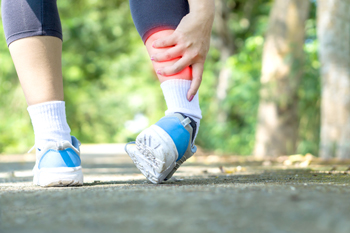 sports, especially among people that play tennis, soccer and run on a regular basis. That is why it is necessary to take some precautions in order to prevent injury. To start off, it is important to warm up the muscles before a sporting activity. Doing a light stretch and a slow jog for two to three minutes will do the trick. A second tip is to condition your muscles. The amount of time spent on a certain activity should be increased gradually over a period of a couple weeks to build both muscle strength and mobility. A third tip is to choose athletic shoes that specifically fit your foot type. People whose feet pronate or who have low arches need shoes that provide support in both the front of the shoe and under the arch. It is also recommended to choose a shoe with more cushion and a softer platform. A fourth tip is to avoid running or stepping on uneven surfaces. Holes, tree stumps, roots and paths with a rocky terrain or loose gravel should be avoided when running. If you have ankle problems, it is best to run on a softer surface like asphalt instead of concrete. A final tip is to listen to your body. If foot and ankle pain is experienced during a sport, you should stop taking part in the activity until the pain fully subsides. It is vital to go through a full rehabilitation process before returning to the sport. This is done to prevent any recurrent injuries. If you have sustained a foot or ankle injury while playing a sport, it is advised to see a podiatrist.
sports, especially among people that play tennis, soccer and run on a regular basis. That is why it is necessary to take some precautions in order to prevent injury. To start off, it is important to warm up the muscles before a sporting activity. Doing a light stretch and a slow jog for two to three minutes will do the trick. A second tip is to condition your muscles. The amount of time spent on a certain activity should be increased gradually over a period of a couple weeks to build both muscle strength and mobility. A third tip is to choose athletic shoes that specifically fit your foot type. People whose feet pronate or who have low arches need shoes that provide support in both the front of the shoe and under the arch. It is also recommended to choose a shoe with more cushion and a softer platform. A fourth tip is to avoid running or stepping on uneven surfaces. Holes, tree stumps, roots and paths with a rocky terrain or loose gravel should be avoided when running. If you have ankle problems, it is best to run on a softer surface like asphalt instead of concrete. A final tip is to listen to your body. If foot and ankle pain is experienced during a sport, you should stop taking part in the activity until the pain fully subsides. It is vital to go through a full rehabilitation process before returning to the sport. This is done to prevent any recurrent injuries. If you have sustained a foot or ankle injury while playing a sport, it is advised to see a podiatrist.
Foot and ankle trauma is common among athletes and the elderly. If you have concerns that you may have experienced trauma to the foot and ankle, consult with Dr. Steven Schwartz from Pennsylvania. Our doctor will assess your condition and provide you with quality foot and ankle treatment.
Foot and ankle trauma cover a range of injuries all over the foot; common injuries include:
- Broken bones
- Muscle strains
- Injuries to the tendons and ligaments
- Stress fractures
Symptoms
Symptoms of foot and ankle injuries vary depending on the injury, but more common ones include:
- Bruising
- Inflammation/ Swelling
- Pain
Diagnosis
To properly diagnose the exact type of injury, podiatrists will conduct a number of different tests. Some of these include sensation and visual tests, X-rays, and MRIs. Medical and family histories will also be taken into account.
Treatment
Once the injury has been diagnosed, the podiatrist can than offer the best treatment options for you. In less severe cases, rest and keeping pressure off the foot may be all that’s necessary. Orthotics, such as a specially made shoes, or immobilization devices, like splints or casts, may be deemed necessary. Finally, if the injury is severe enough, surgery may be necessary.
If you have any questions, please feel free to contact our offices located in Chambersburg, and Mcconnellsburg, PA . We offer the newest diagnostic and treatment technologies for all your foot care needs.
Possible Treatment of Ingrown Toenails
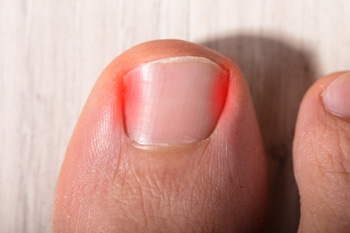 When the side of the toenail grows into the surrounding skin, an ingrown toenail has developed. The symptoms that are commonly associated with this condition include redness, swelling, and tenderness. If it is not promptly treated, severe pain and discomfort may develop from a potential infection. Ingrown toenails may be common among patients with diabetes or poor circulation. Effective treatment options can include removing the part of the nail that is growing into the skin, in addition to treating the nail bed. This may help to prevent an infection from occurring again. If you have developed this uncomfortable ailment, it is advised to consult a podiatrist as quickly as possible to begin proper treatment.
When the side of the toenail grows into the surrounding skin, an ingrown toenail has developed. The symptoms that are commonly associated with this condition include redness, swelling, and tenderness. If it is not promptly treated, severe pain and discomfort may develop from a potential infection. Ingrown toenails may be common among patients with diabetes or poor circulation. Effective treatment options can include removing the part of the nail that is growing into the skin, in addition to treating the nail bed. This may help to prevent an infection from occurring again. If you have developed this uncomfortable ailment, it is advised to consult a podiatrist as quickly as possible to begin proper treatment.
Ingrown toenails can become painful if they are not treated properly. For more information about ingrown toenails, contact Dr. Steven Schwartz of Pennsylvania. Our doctor can provide the care you need to keep you pain-free and on your feet.
Ingrown Toenails
Ingrown toenails occur when a toenail grows sideways into the bed of the nail, causing pain, swelling, and possibly infection.
Causes
- Bacterial infections
- Improper nail cutting such as cutting it too short or not straight across
- Trauma to the toe, such as stubbing, which causes the nail to grow back irregularly
- Ill-fitting shoes that bunch the toes too close together
- Genetic predisposition
Prevention
Because ingrown toenails are not something found outside of shoe-wearing cultures, going barefoot as often as possible will decrease the likeliness of developing ingrown toenails. Wearing proper fitting shoes and using proper cutting techniques will also help decrease your risk of developing ingrown toenails.
Treatment
Ingrown toenails are a very treatable foot condition. In minor cases, soaking the affected area in salt or antibacterial soaps will not only help with the ingrown nail itself, but also help prevent any infections from occurring. In more severe cases, surgery is an option. In either case, speaking to your podiatrist about this condition will help you get a better understanding of specific treatment options that are right for you.
If you have any questions please feel free to contact our offices located in Chambersburg, and Mcconnellsburg, PA . We offer the newest diagnostic and treatment technologies for all your foot and ankle needs.
Possible Causes of Cracked Heels
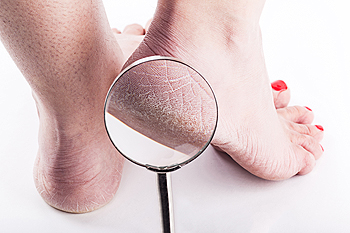 The medical condition that is referred to as cracked heels originates from having extremely dry skin on the heel area of the foot. This can come from standing for extended periods of time throughout the day, or from having certain medical conditions that may include psoriasis. Many people who are overweight experience cracked heels, as a result of the added weight the feet must endure. Additionally, if open back shoes are frequently worn, this condition may develop due to inadequate support these types of shoes provide. The symptoms that are often associated with this ailment include a thickening of skin on the outside of the heel. The skin may turn a dark brown or yellowish color, and cracks in the skin can develop as weight is placed on the heel. This affliction can cause severe pain and discomfort. Mild relief may be found when the feet are washed and dried daily, followed by thoroughly moisturizing them. If you have developed cracked heels, it is advised to consult with a podiatrist who can guide you toward healing and prevention techniques.
The medical condition that is referred to as cracked heels originates from having extremely dry skin on the heel area of the foot. This can come from standing for extended periods of time throughout the day, or from having certain medical conditions that may include psoriasis. Many people who are overweight experience cracked heels, as a result of the added weight the feet must endure. Additionally, if open back shoes are frequently worn, this condition may develop due to inadequate support these types of shoes provide. The symptoms that are often associated with this ailment include a thickening of skin on the outside of the heel. The skin may turn a dark brown or yellowish color, and cracks in the skin can develop as weight is placed on the heel. This affliction can cause severe pain and discomfort. Mild relief may be found when the feet are washed and dried daily, followed by thoroughly moisturizing them. If you have developed cracked heels, it is advised to consult with a podiatrist who can guide you toward healing and prevention techniques.
Cracked heels are unsightly and can cause further damage to your shoes and feet. If you have any concerns, contact Dr. Steven Schwartz from Pennsylvania. Our doctor can provide the care you need to keep you pain-free and on your feet.
Cracked Heels
Cracked heels appear unappealing and can make it harder for you walk around in sandals. Aside from looking unpleasant, cracked heels can also tear stockings, socks, and wear out your shoes. There are several methods to help restore a cracked heel and prevent further damage.
How Do You Get Them?
Dry skin is the number one culprit in creating cracked heels. Many athletes, walkers, joggers, and even swimmers suffer from cracked heels. Age and skin oil production play a role to getting cracked heels as well.
Promote Healing
Over the counter medicines can help, especially for those that need instant relief or who suffer from chronic dry feet.
Wear Socks – Wearing socks with medicated creams helps lock in moisture.
Moisturizers – Applying both day and night will help alleviate dryness which causes cracking.
Pumice Stones – These exfoliate and remove dead skin, which allows for smoother moisturizer application and better absorption into the skin.
Change in Diet
Eating healthy with a well-balanced diet will give the skin a fresh and radiant look. Your body responds to the kinds of food you ingest. Omega-3 fatty acids and zinc supplements can also revitalize skin tissue.
Most importantly, seek professional help if unsure how to proceed in treating cracked heels. A podiatrist will help you with any questions or information needed.
If you have any questions, please feel free to contact our offices located in Chambersburg, and Mcconnellsburg, PA . We offer the newest diagnostic and treatment technologies for all your foot care needs.



